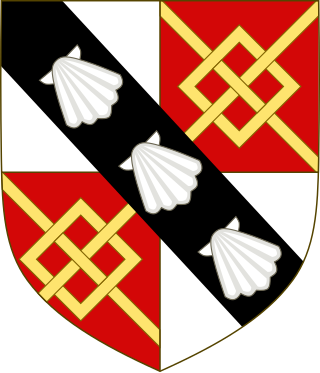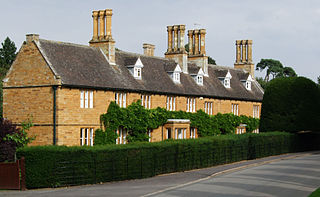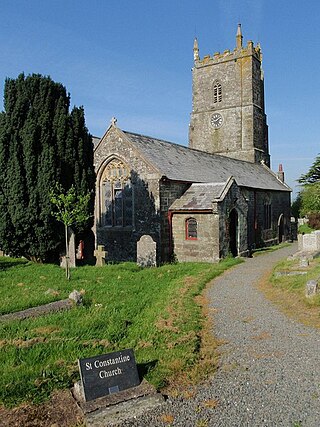
The Spencer family is an aristocratic family in the United Kingdom. From the 16th century, its members have held numerous titles, including the dukedom of Marlborough, the earldoms of Sunderland and Spencer, and the Churchill barony. Two prominent members of the family during the 20th century were Sir Winston Churchill and Diana, Princess of Wales.

Little Barford is a hamlet and civil parish in the Borough of Bedford in Bedfordshire, England about 7 miles (11 km) northeast of the county town of Bedford.

Cottesbrooke is a village and civil parish in West Northamptonshire in England. At the time of the 2001 census, the parish's population was 144 people, falling marginally to 143 at the 2011 census.

Bedfordshire is an English ceremonial county which lies between approximately 25 miles and 55 miles north of central London.

Harlington is a village and civil parish located in Bedfordshire, England, near the M1 motorway. The nearest town is Flitwick about 3 miles (4.8 km) to the north.

Turvey is a village and civil parish on the River Great Ouse in the Borough of Bedford, Bedfordshire, England, about 7 miles (11 km) west of Bedford town centre. The village is on the A428 road between Bedford and Northampton, close to the border with Buckinghamshire. The 2011 Census recorded the parish's population as 1,225.

Swineshead is a village and civil parish in the Borough of Bedford in the county of Bedfordshire, England.
Oakley is a village and civil parish located in the Borough of Bedford in Bedfordshire, England, about four miles northwest of Bedford along the River Great Ouse. It has a population of 2,493 and is near the villages of Bromham, Milton Ernest, Clapham, Radwell and Felmersham.
John Mottrom, or Mottram, was one of the first, if not the first, white settlers in the Northern Neck region of Virginia between 1635 and 1640.

Houghton Conquest is a village and civil parish located in the Central Bedfordshire district of Bedfordshire, England. The parish also includes the hamlet of How End.

Ravensden is a village and civil parish located in the Borough of Bedford in Bedfordshire, England.

Colonel Nicholas Spencer, Jr. (1633–1689) was a merchant, planter and politician in colonial Virginia. Born in Cople, Bedfordshire, Spencer migrated to the Westmoreland County, Virginia, where he became a planter and which he represented in the Virginia House of Burgesses. Spencer later served as Secretary and President of the Council of the Virginia Colony, and on the departure of his cousin Thomas Colepeper, 2nd Baron Colepeper in 1683, was named Acting Governor (1683–84), in which capacity Spencer served until the arrival of Governor Lord Howard of Effingham. Spencer's role as agent for the Culpepers helped him and his cousin Lt. Col. John Washington, ancestor of George Washington, secure the patent for their joint land grant of the Mount Vernon estate.

Sir Thomas Kitson was a wealthy English merchant, Sheriff of London, and builder of Hengrave Hall in Suffolk.
Sir Oliver Luke (1574–c.1651) of Woodend, Cople and Hawnes, Bedfordshire was an English politician who sat in the House of Commons of England from 1614 to 1648.

Huntsham is a small village and civil parish, formerly a manor and ecclesiastical parish, in the Mid Devon district of Devon, England. The nearest town is Tiverton, about 5.8 miles (9.3 km) south-west of the village. The parish is surrounded clockwise from the north by the parishes of Bampton, Hockworthy, Uplowman and Tiverton; it is bounded on the east by the River Lowman and by a minor road on Bampton Down to the north west, where it reaches a maximum height of 914 feet (279 m). In 2001 the population of the parish was 138, down from 222 in 1901.
Martin Culpepper was an English clergyman, medical doctor, and academic at the University of Oxford.

Sir Simon Leach (1567–1638) of the parish of All Hallows, Goldsmith Street, Exeter and of Cadeleigh, Devon, was Sheriff of Devon in 1624. His surviving monument in St Bartholomew's Church, Cadeleigh is the largest of its type in any Devon parish church.

Milton Abbot is a village, parish, and former manor in Devon, 6 miles (9.7 km) north-west of Tavistock, Devon, and 6 miles (9.7 km) south-east of Launceston, Cornwall.

Scoble, is an historic estate in the parish of South Pool near the south coast of Devon, England. The present Scoble House, located about 1 mile west of the village of South Pool, is a Grade II* listed building built circa 1720-40, probably around a more ancient core, with early 19th c. additions. It is a "tall stone house in a remote position" which represents a "slightly provincial, but nonetheless interesting example of an early - mid 18th century gentleman's house which has a remarkably complete interior and has not suffered from any extreme C20 modernisation."
Sir Edward Gostwick, 2nd Baronet was an English aristocrat.

















